 |
|
This house is a combination of ideas, a culmination of 16 years (if you figure it since when we got our first chickens) of figuring out what I do and don't like in a chicken coop--and my brother saying "uh, no, that won't work." :-) He did the foundation, we both worked on building it (he did more!), he put up the roof, I put up the wire, and I painted it. To be honest I'm amazed this coop exists (thank you Mom for funding it!). I really didn't think any amount of begging or pleading could produce yet another chicken coop, but somehow this one exists anyhow. It started out as a few sketches I did on paper, which were "edited" and reworked by someone who actually knows how to build things (my brother). So it's modified a bit from what I originally sketched out, but the overall design (center aisle, tall individual coops on each side) remains. There are elements of this coop that I've seen at other people's ranches--things I like. There were certain things I wanted to avoid. Compared to the other coops this is a whole new design for us, and for once it doesn't utilize "found" parts! So why did I feel the need for yet another chicken coop? Well, I needed something for keeping the birds in condition. Especially the males... It had been years since I had shown a male Rosecomb in decent condition--I had no choice but to keep them in small groups, and by the time show season rolled around they had dinged up ear lobes and ruined sickles, and were relegated to "breeder" status. I hardly ever had pullets in condition either, except at the very beginning of the season. Too much time in the great outdoors led to frayed wingtips. So how could I solve this problem? The original idea was for a rooster house, where cockerels could be penned individually, on shavings, no outdoor access (hated to do that, but it's the only way with those big tails!), and OFF THE GROUND as much as possible. Individual cages were not an option: there wasn't anywhere to put that kind of setup, and no way was I going to deal with feeding and watering every bird every day. Besides, I wanted them to have more room than that. I had seen a design a few years ago that the owner referred to as "phone booths" and this struck me as a really good idea for Rosecomb males. The coops were not very deep and not very wide, but very tall, with a perch, feeder, and waterer up near the top. This forced the birds to use their wings, and kept the feed and water somewhat cleaner. So this is what we came up with... (I may have to put a mural on that wall, I'm not sure I can handle such a large blank area). :-)
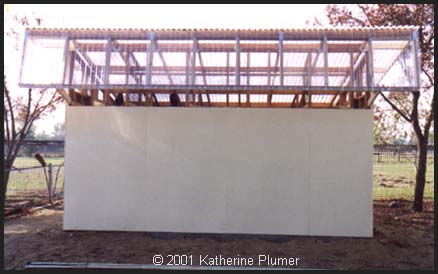 A view from the East.
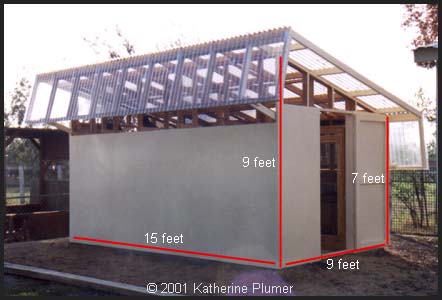 From the Northeast...with dimensions!
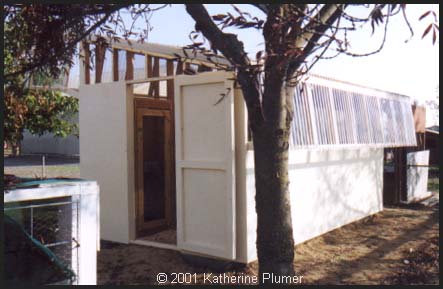 From the Northwest (sorry about the tree...I couldn't get around it!)
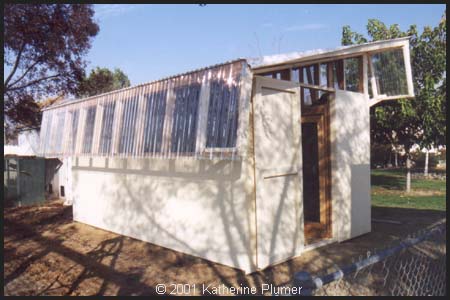 From the Southwest... Its dimensions are 15 feet wide, 9 feet long, and 7-9 feet tall (it slopes). Did it have to be so tall? No, in fact when I came back from a show one weekend my brother had put the walls up and my word I had no idea it was going to be so big! He said something about needing the proper slope angle for the roofing. It's not a problem though, and given the opportunity the birds use the whole space. It sits on a concrete foundation, surrounded by 9 cubic yards of dirt (the aisle way and pens are topped off with decomposed granite...packs down really well!). The cats are fairly sure it's the "grand litter box." Oh joy. The coops themselves (ten of them) are 3 by 3 feet, by as tall as the house itself. The coop doors are roughly 3 by 6 feet (the door frame, anyhow). The perches are 5.5-6 feet off the floor, and the birds have no problem getting up there (they generally go to the door-perch or window-sill first. The perches are PVC, because that's what we had sitting around...so why go out and buy closet-rods? Between each coop is 1" aviary netting--a whole lot easier to fit into odd spaces than chicken wire (it stretches!), doesn't repeatedly poke whoever is putting it up (that'd be me), and is not much more expensive...and looks way cool too. I really like that netting. The "open" parts of the walls are covered with chicken wire (also covered with shade cloth on the Western wall). There is a door at each end of the aisle way, which can be latched open or closed depending on the weather (I leave it open unless it's nasty weather). The dogs and cats wander through, but I figure that's good conditioning for the birds. The West and East side each have what we call a "sneeze guard" (like at the salad bar...just seemed like a good name for a new idea). This is my brother's idea, and solved the problem of how to have an open wall that's still protected from the weather. It's clear plastic roofing on a wooden frame, attached to the roof frame, and braced onto the wall of the house itself. Pretty cool! The roof is white plastic, and is great. It lets in so much light that even with the doors closed there is virtually no decrease in the lightness inside. The last coop we built has a tin roof, and that seems SO dark compared to this one. The water system is all automatic. PVC pipes run ~8 inches underground along the length of each side, and there is 1/2 inch metal upright pipe for every other pen (it branches at the top to serve two pens). The waterers are Little Giant automatic founts. They are easy to clean, relatively maintenance-free (sometimes have to replace a valve or adjust water level) and do not require a low-pressure system. As you can see (see photos below), the waterers are quite high off the ground. Since Rosecombs have not perfected the art of hovering (ha ha), they access the waterer (and the feeder) from a perch that is attached to the door. The perch (a piece of 2x4) is attached to the door with metal shelf brackets. This is super-duper--keeps everything off the ground and so much cleaner. The only problem is that if the birds turn around on the door perch (which they do) their feathers rub against the wire. A piece of corrugated plastic (or something similar) would solve that problem. At first the birds also had a tendency to sit on the "window sill" above the feeder, and well...that got kinda messy, so I stretched some wires tight across that space, and now they don't go up there anymore unless it's some dire emergency...like the lawn mower or something (sheesh). I currently have 13 birds in it (8 individually cooped cockerels, and 5 pullets) And now...pictures!!! Oh, I should warn you, due to the extreme vertical nature of this chicken house it is NOT easy to photograph! (it's also so close to the fence and another coop that it's tough to get a good exterior view too). 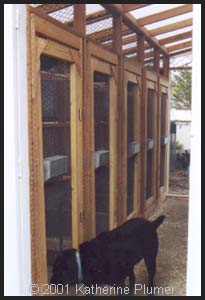 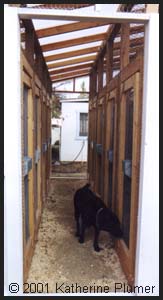 Two views down the center aisle (with Jessie cleaning up crumbs, how cute).
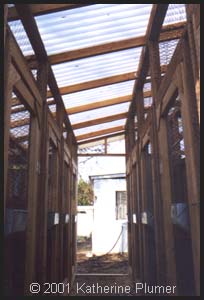 A somewhat better view down the center aisle.
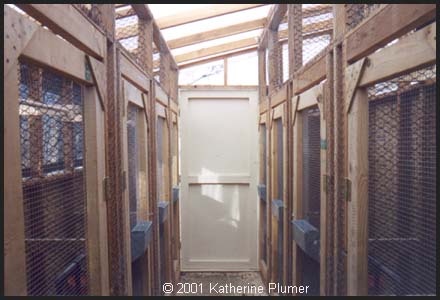 Ooh! Look how light it still is even with both doors shut!!
 The "sneeze guard."
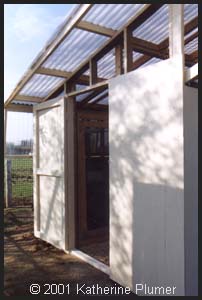 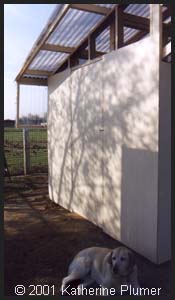 Left: aisle door open. Right: aisle door closed (see, it matches Nellie!!)
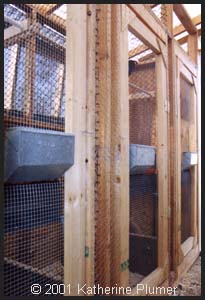 The doors.
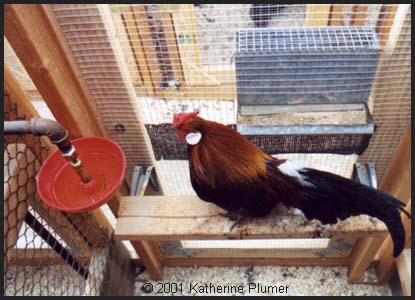 I took this while standing in this bird's pen against the back wall, looking towards the aisle way. As you can see, the perch that allows the birds to access the feeder and waterer is connected to the door itself (therefore swings conveniently out of the way when the door it opened!). The waterers are all automatic, and the feeders are the type that are filled from the outside.
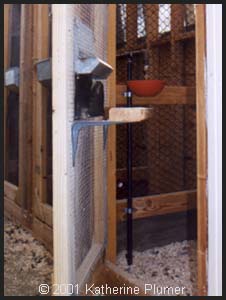 Another look at how the birds can access the feeder and waterer from a perch that is attached to the door. 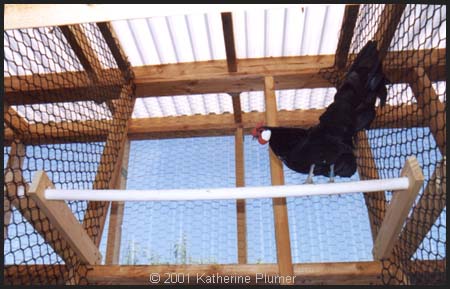 This was taken while kneeling down in front of the open door, looking up. He is 6 feet off the ground. A good view of the aviary netting, the white roof, and the perch construction.  This was taken while standing in front of the open door, looking down. As you can see, a 3x3 pen holds a few pullets quite nicely! The bottom 1 foot of each dividing wall is plywood, to keep the fighting between pens (and feather damage) to a minimum. All in all, a GREAT chicken coop, and it looks so good! As my brother says this is my last chicken coop, at least until I'm a gazillionaire (or marry one!) and can afford to hire someone to build that round marble central-plan (oh fond memories of art history!) coop that I want (ha ha)...with the Corinthian columns and a nice running-chickens relief sculpture on the frieze...keep dreaming... :-) So that's it, those are the chicken houses I have known! |
|
copyright © 1999-2011 Katherine Plumer, all rights reserved
|